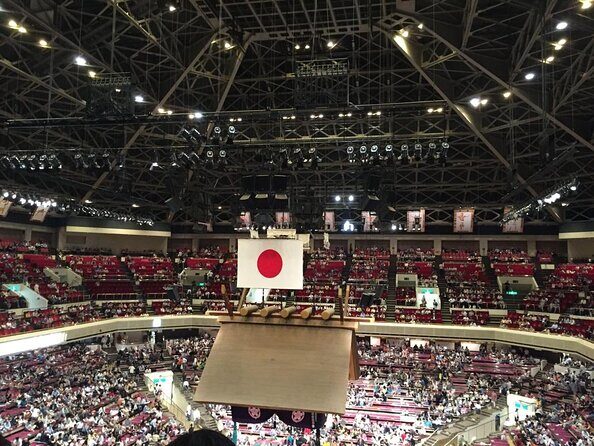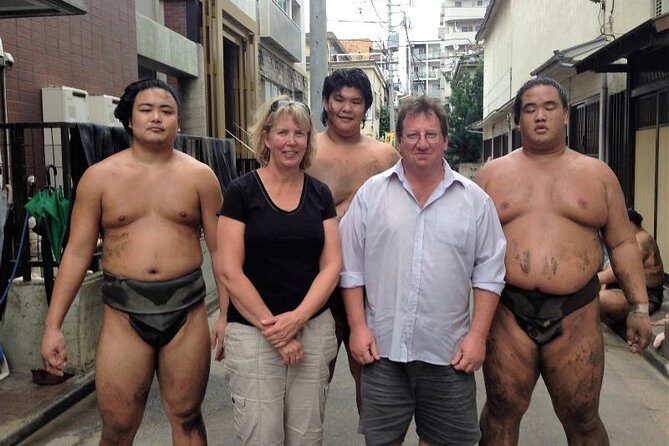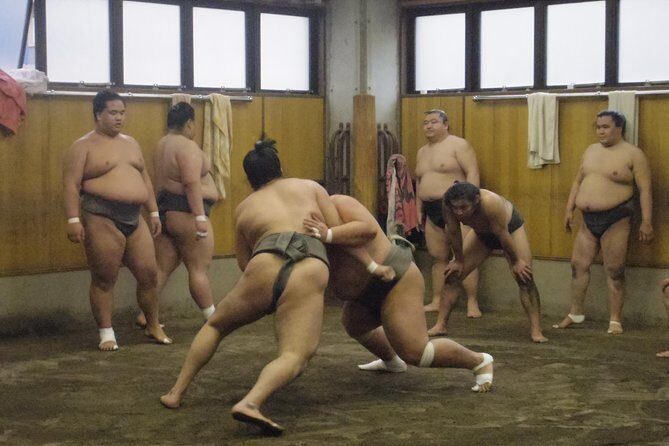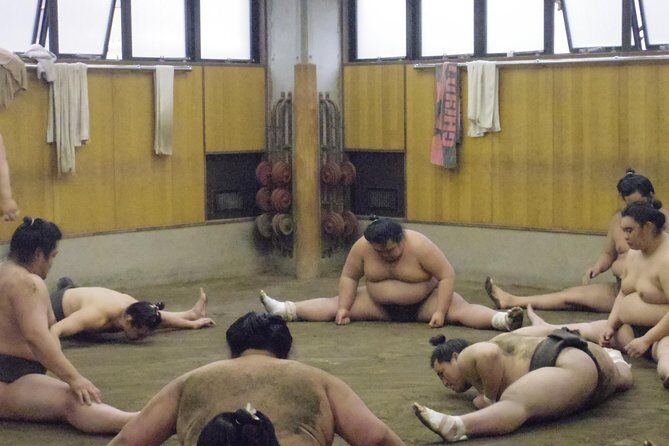A Close-Up Look at Japan’s Ancient Sumo Tradition
This tour takes you inside a sumo stable in Tokyo, where you’ll spend around 2 hours observing the daily training routines of some of Japan’s most formidable athletes. For $124 per person, you meet your guide early in the morning—around 7:45 am—and head into the world of sumo wrestling, an age-old sport deeply tied to Shinto rituals and Japanese culture.
What we love about this experience is how up close and personal it feels—you’re not just watching from afar but standing right near these imposing wrestlers as they go through their rigorous practice. Plus, the knowledgeable guides make everything clear, turning what might seem like just brawling into an insightful lesson in tradition, discipline, and history.
One possible consideration is that the practice can be quite long, sometimes lasting around 3 hours, which might test your patience or energy, especially in summer heat. Also, the tour is designed to be respectful and silent, so if you’re expecting a lively, noisy spectacle, this might be different from what you think.
This tour suits those genuinely interested in Japanese sports and culture, especially travelers who appreciate authentic experiences. If you’re intrigued by traditional rituals and want to see sumo wrestlers in action, this is a top choice.
Key Points

- Exclusive access to a sumo stable provides a rare glimpse into the sport’s daily life.
- Learn about sumo’s origins and its connection to Shinto traditions that date back centuries.
- Observation of training routines gives insight into the discipline and physicality required.
- Knowledgeable guides enhance understanding and answer questions, making the experience richer.
- Close proximity to wrestlers allows for a visceral, memorable experience.
- Respect and silence are essential; you’re there to observe, not disturb.
Exploring Tokyo’s Sumō World: An In-Depth Review

While in Tokyo, here are other experiences we've covered
Setting the Scene: What You Can Expect
From the moment you join the tour, you are stepping into a rare corner of Japanese culture that most travelers never see. Meeting your guide at Ryogoku Station, the heart of Tokyo’s sumo scene, you’ll feel the anticipation build. The tour lasts roughly 2 hours, during which you’ll visit a sumo stable, possibly the Sumo Museum if time permits, and view the famous Ryogoku Kokugikan outside the tournament season.
Your guide, like many reviewers mention, is knowledgeable and friendly, sharing insights into how sumo’s rituals and training routines have persisted for over 1500 years. Expect to learn about the six annual grand tournaments, primarily held in Tokyo, Osaka, Nagoya, and Fukuoka—making this experience a perfect primer if you plan to attend in person later.
The Stable Experience: A Window into Sumō’s Daily Grind
The core of the tour is inside the stable, where you’ll witness wrestlers perform their morning exercises. These routines are grueling, often lasting around 3 hours, but what impresses most is the discipline and focus they demonstrate. Many reviews highlight how powerful and flexible the wrestlers are, with one describing them as “really strong and flexible.”
The atmosphere is one of quiet concentration—wrestlers focus intently, and spectators are asked to remain silent and respectful. You’re allowed to take photos—without flash and without shutter sounds—though the video recording is strictly prohibited. Here, you’ll see senior wrestlers giving advice and junior wrestlers practicing—a real look at the hierarchical nature of sumo.
Why This Matters for You
Watching these athletes train gives you a deeper appreciation for the discipline and sacrifice behind sumo. As one reviewer put it, it’s “mesmerizing” to see their concentration and power in silence. Many describe the scene as a Zen-like experience, feeling almost tranquil despite the physical effort.
Additional Stops and Cultural Insights
If time allows, you may visit the Sumo Museum, which houses vintage photos, wrestling gear, and exhibits about sumo’s history and rituals. Walking past the Kokugikan—the main arena where grand tournaments are held—also adds to the sense of being part of this living tradition.
- Düsseldorf: Manga, mochi & more Düsseldorf’s Little Tokyo
- From Tokyo: Mt. Fuji Spanish & English Tour
- Downtown Los Angeles : Historic district & Little Tokyo
- Outdoor Escape Room in LA – Little Tokyo
- LA Little Tokyo to Olvera St Smartphone (App/GPS) Walking Tour
- 1-Day Mt Fuji and Hakone Sightseeing trip from Tokyo
Practical Details and Group Dynamics
This tour is limited to 20 travelers, making it intimate enough to hear your guide and ask questions during the experience. The group size and the small, respectful setting are often praised in reviews as making the visit feel authentic and personal.
Transportation is included in the sense that you meet near Ryogoku Station—well-connected by public transit—making it easy to fit into a day of sightseeing. Be prepared for a hot summer; the stable has no air conditioning but allows water and sports drinks inside, and travelers are encouraged to bring cooling towels or ice packs.
What Reviewers Say
Many highlight how knowledgeable guides like Yuriko or Kiki enhance the experience with interesting commentary. As one reviewer states, “Yuriko made it an even better experience,” reflecting how personalized insights deepen your understanding.
Several reviewers mention how powerful and loud the crashes are—“louder than expected”—and how witnessing the sweat, effort, and hierarchy is more impactful than just reading about sumo. Others mention how the silence and focus create a zen-like atmosphere, making it a profound moment in their Japan trip.
Cost and Value
At $124, the tour offers exceptional value considering the rare access and professional guidance. You get a front-row view of authentic training, learn about sumo’s cultural roots, and see the wrestlers’ daily lives—a memorable, photo-worthy experience that’s well worth the price for fans of Japanese traditions or sports enthusiasts.
Limitations and Considerations
While many rave about this tour, some mention that training sessions can be quite long and the environment noisy due to the stable’s activity. It might not be suitable for very young children (minimum age is 12), and hot weather can make it uncomfortable if you’re not prepared. Also, questions are generally asked after the practice, so if you’re eager to speak with wrestlers during the session, that’s not the format here.
Who Will Love This Tour?

This experience is ideal for culture buffs eager to see an authentic slice of Japan, especially those interested in traditional sports and rituals. It’s perfect if you enjoy up-close observations, and don’t mind quiet, disciplined environments. If you’re a sports fan or someone curious about Japanese history, this tour offers a fascinating behind-the-scenes look that’s both educational and awe-inspiring.
Frequently Asked Questions (FAQ)
Do I need to book in advance?
Yes, most travelers book about 23 days ahead on average, as spots fill quickly due to limited group size and exclusive access.
What should I wear or bring?
Dress comfortably and be prepared for warm weather in summer. Bring water, possibly a cold towel or ice pack, to stay cool. Avoid sunglasses and hats inside the stable, and wear respectful clothing—no sandals or revealing attire.
Can I take photos during the practice?
Photos are permitted without flash or shutter sounds, but videos are not allowed. Be respectful and silent during the session.
What’s the minimum age to participate?
Minimum age is 12 years old. Children 11 and under cannot enter the stable.
Is transportation included?
You meet at a designated location near Ryogoku Station, which is accessible by public transit. The tour may include a short train ride to the stable.
Can I ask questions during the tour?
Questions are encouraged after the practice session. During the training, silence and respect are expected, but your guide will happily answer your questions afterward.
Final Thoughts

Choosing this sumo morning practice tour means gaining intimate access to a sacred tradition that’s been part of Japan for centuries. You’ll see powerful athletes in action, learn about rituals, and develop an appreciation for the dedication required to compete at such a high level.
For those who value authentic experiences, enjoy cultural insights, and want to see sumo in its natural environment, this tour offers more than just a glimpse—it’s an immersive journey into Japan’s ancient sport.
While it’s not suited for travelers seeking a lively, noisy spectacle or with very young children, it is perfect for curious minds and cultural explorers. Expect to leave with a deeper understanding of sumo’s significance and a set of memorable images from a truly unique experience.
You’ll love the way this tour combines history, sport, and tradition into a genuine, respectful, and powerful look at sumo wrestling. It’s a rare glimpse into an aspect of Japan that many miss, making it a highlight for those wanting an authentic cultural encounter.
More Morning in Tokyo
- Morning Sumo Practice Viewing in Tokyo
- [Photos with Wrestlers] Exclusive Access to Sumo Morning Practice
- Toyosu Market Morning Tuna Auction and Tsukiji Food Tour with Licensed Guide
- Tokyo Sumo Morning Practice & Exclusive Behind-the-Scenes Access
- Tokyo: Sumo Morning Practice Viewing Tour at a Real Stable
- Tokyo Morning Tour: Meiji Shrine, Asakusa & Fish Market
More Tours in Tokyo
More Tour Reviews in Tokyo
More Tokyo experiences we've covered
- Private Tour Guide in English or Spanish (Español)
- Morning Sumo Practice Viewing in Tokyo
- Authentic Sumo Experience in Tokyo : Enter the Sanctuary
- Secret Food Tours Tokyo w/ Private Tour Option
- Tokyo: Tsukiji Fish Market Seafood & Street Eats
- Tokyo 4hr Private Tour with Government-Licensed Guide
- Old Town Tokyo Food Tour
- 3hr Private E-bike Tours in Tokyo, Starting at your hotel
- [Photos with Wrestlers] Exclusive Access to Sumo Morning Practice
- Sake Tasting Class with a Sake Professional
- Narita Airport Private Transfer to Tokyo/Yokohama/MountFuji/Osaka
- Fish Market Food Tour in Tokyo
